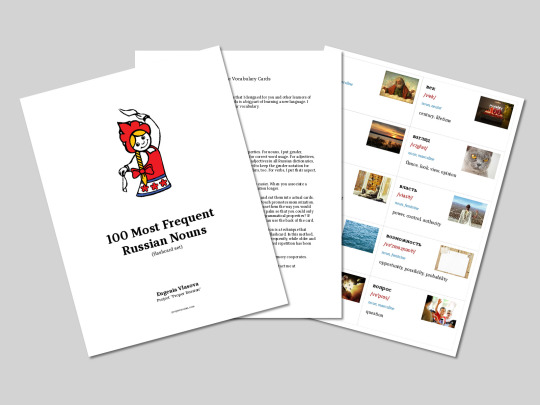#LanguageTeache
Explore tagged Tumblr posts
Text

Elevate your Russian language aspirations by focusing on what truly matters! As your dedicated language guide, I've meticulously curated a set of handmade vocabulary cards featuring the most frequently used nouns in Russian.
If mastering Russian is at the pinnacle of your New Year resolutions, kickstart your linguistic journey by immersing yourself in the first 100 high-impact nouns. Each thoughtfully crafted card holds the key to your language progression, offering:
🔍 A Russian word, carefully chosen from the most common lexicon for practical proficiency.
🎙️ Its IPA transcription, ensuring your pronunciation aligns with native fluency.
📘 Grammatical insights into the word, deepening your grasp of its contextual usage.
🌐 An English translation, forming a bridge between languages for comprehensive understanding.
🖼️ A vivid visual aid, capturing the essence of the word to enhance your memory.
Discover firsthand the simplicity and enjoyment my students have experienced, affirming these cards as a delightful and effective memorization tool. Make your Russian studies not only efficient but also enjoyable—immerse yourself in the world of these frequency-based cards today! 🚀✨
16 notes
·
View notes
Photo

Email like a boss
#LanguageLearning#LearnLanguages#Polyglot#SpeakFluent#LanguageLearner#LanguageGoals#LanguageJourney#LanguageExchange#LearnWithMe#Linguistics#LanguageTips#LanguageNerd#BilingualLife#LanguageChallenge#LanguageStudy#LanguageCommunity#FluentInDays#LanguageTeacher#LearnAndGrow#LanguageAcquisition#LearnersOfInstagram#PolyglotCommunity#LanguageResources#LanguageEnthusiast#LanguageMemes#SpeakLikeANative#LanguagePodcasts#LanguageBooks#LanguageLearningTips#LanguageInspiration
93 notes
·
View notes
Text
Teaching = connecting
Teaching, at its core, is a deeply human endeavor. Beyond instructional strategies and curriculum outcomes, what often sustains teachers through the demands of the profession is not just the act of teaching itself but the relationships formed within it. Human connection in the classroom is not a sentimental bonus; it is a central, evidence-based contributor to both teacher effectiveness and well-being.
Educational psychology increasingly acknowledges teaching as an emotionally laborious and relational practice. As Hargreaves (1998) asserted in his seminal work, The Emotional Practice of Teaching, "Good teaching is charged with positive emotion. It is not just a matter of knowing one's subject, being efficient, having correct competencies, or learning the right techniques." Rather, good teaching “arises out of the relationships teachers build with their students.”
This idea is echoed and expanded upon by Sarah Mercer (2016), who emphasizes that language teaching in particular is inherently affective and relational. She argues that the quality of interpersonal relationships in the classroom significantly impacts both learner success and teacher well-being. Teachers who feel connected to their students are more likely to experience intrinsic motivation, job satisfaction, and resilience (Mercer, 2016; Yin et al., 2019).
From a cognitive science perspective, the social brain hypothesis suggests that our brains are evolutionarily wired for connection (Dunbar, 1998). Social interactions stimulate neural circuits related to empathy, reward, and meaning-making suggesting that the emotional bonds we form in classrooms are not only psychologically satisfying but neurologically reinforcing. This could explain why something as simple as a student’s enthusiastic participation, or an appreciative glance during a lesson, feels deeply rewarding.
Positive psychology offers further insight. Fredrickson’s Broaden-and-Build Theory of Positive Emotions (2001) posits that positive emotional exchanges such as those between teacher and student enhance our cognitive flexibility, build resilience, and create upward spirals of well-being. These brief yet powerful moments of interpersonal resonance contribute not only to teacher flourishing but to more dynamic, trusting classroom environments.
In practical terms, these human interactions can turn a routine lesson into something meaningful. A simple “thank you” after class, a student bravely asking a question, or the shy learner finally laughing out loud, these micro-moments of trust and joy are small, but they accumulate. They are often what teachers remember long after the term ends.
As a language teacher, I often receive affirmations from my students, verbal and non-verbal, that they feel safe, seen, and engaged. These connections don’t just help them learn. They help me teach.
There are days when I enter the classroom exhausted, uncertain, or quiet from life’s weight. And then, something shifts. A student greets me with a smile, another asks a follow-up question from yesterday’s lesson, and sometimes the quietest one says, “I like today’s activity.” These may seem like small things, but in the life of a teacher, they are everything. They remind me that presence matters. That being human in the classroom isn't a flaw; it's a gift.
And so, while we prepare our materials and plan our outcomes, it’s worth remembering that no learning happens in a vacuum. The relational space we co-create with our students may be the most powerful pedagogy of all.
It is in those shared silences, honest laughter, and mutual care that we not only build understanding but belonging. And in that belonging, we teach and are taught in return.
How do you nurture meaningful connections in your own learning or teaching spaces?
Selected References:
Fredrickson, B. L. (2001). The role of positive emotions in positive psychology: The broaden-and-build theory of positive emotions. American Psychologist, 56(3), 218–226.
Hargreaves, A. (1998). The emotional practice of teaching. Teaching and Teacher Education, 14(8), 835–854.
Mercer, S. (2016). Teacher well-being and the complexity of language teaching. In Gkonou, T., Tatzl, D., & Mercer, S. (Eds.), New Directions in Language Learning Psychology (pp. 103–123). Springer.
Yin, H., Huang, S., & Wang, W. (2019). Work environment characteristics and teacher well-being: The mediation of emotion regulation strategies. International Journal of Environmental Research and Public Health, 16(24), 4701.
Dunbar, R. I. M. (1998). The social brain hypothesis. Evolutionary Anthropology, 6(5), 178–190.
#Teaching#LanguageTeaching#HumanConnection#StudentEngagement#RelationalPedagogy#Education#Learning#TeacherReflection#ClassroomCommunity#EmotionalIntelligence#TeachingWithHeart#EducationResearch#TeacherLife#LanguageLearning#Motivation#StudentSupport#TeachingJourney#Pedagogy#houseofpersimmons#persimmonsrain
7 notes
·
View notes
Text

#LanguageTeaching#EffectiveApproaches#WorldwideEducation#GlobalTeaching#InnovativeMethods#CulturallyResponsive#LanguageLearning#21stCenturyLearning#InternationalEducation#TeacherTraining
0 notes
Text
1º
Inspired by the Women's World Cup last year, I decided to spend my Christmas break learning Spanish with a teacher I found online. I wanted to delve deeper into what this language and culture meant to me, and how they would become part of my life. This was a decision I was willing to turn into a long-term commitment. At this point, I knew three things: 1) basic Spanish greetings, phrases, and numbers, 2) "usted" is formal, and 3) I couldn't pronounce the rolling "r."
When I met my Spanish teacher for the first time, I was excited and nervous. I was... jelly, quivering in anticipation and uncertainty. Looking at her through the screen, I didn't know how to start the conversation... or the lesson... or anything. Was I expected to speak in Spanish now? Should I speak in English and hope she understood? My heart raced as I scrambled to form sentences with the minuscule amount of Spanish I remembered from college.
She smiled at me and began speaking in Spanish, her words flowing in a clear rhythm, yet the sounds were unintelligible to me, much like the post-match interviews I watched during the World Cup. Sheepishly, I responded in English, and she would occasionally smile and reply in English to clarify and explain what had just been said. My jelly-like state evolved into melting jelly, losing shape and coherence under the pressure of this first lesson. I felt like I was slowly melting into a puddle of English words, struggling to maintain my composure and keep up with the grammar. The lesson ended after 50 minutes. At this point, I had learned three things: 1) I actually don't know basic Spanish greetings, phrases, and numbers, 2) in Spain, they don't use "usted" in regular conversations, and 3) the rolling "r" isn't the only Spanish sound I don't know how to pronounce. I realized I had a long way to go with the language. But this was only the first lesson. I had six more in the coming weeks.
#Inspiration#Empowerment#OvercomingChallenges#PersonalJourney#LearningFromScratch#LanguageStruggles#Determination#FirstLesson#LearningSpanish#LanguageTeacher#beginner spanish
0 notes
Text

language teacher, global-jobs.com, https://www.global-jobs.com
#language teacher#languageteacher#languageteachers#trillionairelanguage#languagetrillionaire#millionairelanguage#billionairelanguage#languagecompanies#languageclubs#languagegroups#languageagencies#mylanguage#companieslanguage#clubslanguage#groupslanguage#agencieslanguage#findlanguage#findlanguages#languagecompany#languageclub#languagegroup#languageagency#languagemillionaire#companylanguage#clublanguage#grouplanguage#agencylanguage#languageagent#语言#语言老师
1 note
·
View note
Text
PROGRAMING LANGUAGE

C++
Is a BEST programming language that is widely used for developing computer applications and software. It is a general-purpose programming language known for its efficiency, performance, and low-level control over hardware resources.
#education#student#developers & startups#clanguage#czechlanguage#cprogramminglanguage#computerlanguage#catlanguage#codinglanguage#caninebodylanguage#commonlanguage#creativelanguage#corporatelanguage#csslanguage#languageteacher#englishlanguageteaching#softwareengineer#computerscience#programming#mandarin#coding#python#java#programmer#html#softwaredeveloper#language#computer#javascripts#codingchallenge
0 notes
Text
Become a TEFL/TESOL Teacher NOW!
Become a TEFL/TESOL Teacher NOW! Become a certified English teacher! This video details the Expert Package TEFL/TESOL intensive course: duration, registration, cost, and benefits. Learn about flexible options and financial advantages. Enroll now! #TEFLcertification #TESOLcertification #EnglishTeacher #OnlineCourse #TeacherTraining #ESL #ELT #LanguageTeaching #CareerDevelopment #ProfessionalDevelopment
0 notes
Text
Is my role going to change?
See on Scoop.it - Mundos Virtuales, Educacion Conectada y Aprendizaje de Lenguas
Learning and Development's (L&D's) role has been changing for a long time. I see AI not as a tool or technology but as an invisible energy to accelerate that change. In 2025, this "energy" will manifest as autonomous agents open to the public. These agents will not only assist you in doing tasks but will do the tasks for you. Or, instead of you. "We're not adopting AI to evolve our current L&D tool kit. We're reconsidering everything we do as learning professionals to evolve and stay relevant as a profession. AI will be like wireless in the future. Invisible, yet fundamental to communication and the apps we use. With autonomous agents coming out in 2025, they are literally taking over your tasks".
Dr. Doris Molero's insight:
As AI transforms education, language educators have an incredible opportunity to embrace innovation while preserving the human touch in learning. Their role is no longer just about teaching grammar or vocabulary but guiding students in navigating AI tools like ChatGPT or Copilot to enhance language acquisition. Educators become **facilitators**, helping learners develop critical thinking, creativity, and ethical awareness in using AI. They design engaging activities, such as AI-powered storytelling or conversational simulations, while fostering skills like cultural sensitivity and collaboration that AI cannot replicate. In this era, the teacher’s role is essential: to inspire, to humanize learning, and to empower students to use AI responsibly and effectively. Together, they shape a future where technology enhances—not replaces—the human experience in language learning.
#AIinEducation #LanguageTeaching #Innovation
0 notes
Video
youtube
Inclusive materials in ELT with Tyson Seburn
Interview with Tyson Seburn: Inclusive materials in ELT and LGBTQ+ narratives in ELT classrooms
Join me for an another insightful FRESH CHAT with Tyson Seburn, a prominent voice in the field of English Language Teaching (ELT), as we delve into the critical topic of inclusivity and representation in ELT classrooms and textbooks.
In this interview, Tyson shares his perspectives on the current state of ELT materials, highlighting the significant gap in resources that reflect diverse and queer identities.
📚 Topics Covered:
- The importance of inclusive and queer representation in language learning
- Challenges faced by educators in incorporating diverse materials
- The impact of inclusive content on student engagement and learning outcomes - Strategies for creating and sourcing inclusive ELT resources
- Tyson's personal experiences and insights from his work in the field
👥 About Tyson Seburn:
Tyson Seburn (MA EdTech & TESOL, University of Manchester) is a lecturer in and assistant director of an EAP foundation year at the University of Toronto and tutor on Oxford TEFL Barcelona’s Trinity DipTESOL course. He has volunteered on local and international teacher association committees, most recently as IATEFL TDSIG Coordinator.
His personal and professional experiences inspired his interest in Queer and racialised ELT experiences, and thus ways to better practices and materials. He discusses critical and inclusive pedagogies via his online spaces (fourc.ca and @seburnt).
He is author of Academic Reading Circles (2015) and How to Write Inclusive Materials (2021).
TESOL course:
TEFL Lemon offers an online 180-Hour Higher Certificate in TESOL, which is fully accredited by ACTDEC. Module 19 on our twenty-module course is all about Cultural Awareness, something all TEFL teachers must have, as we are teaching language to people all over the world. Having an understanding of cultural diversity is an essential part of what we do, so much so, that we have dedicated a full module to it, as well as focusing on what is is like living and teaching abroad.
Our TESOL course improves and grows month-by-month, and this interview with Tyson will be added to Unit 19 in the supplementary videos section.
To take our course and get 20% OFF the cost, go to this link and use our discount coupon below: https://www.tefllemoncourses.com/checkout/Course/20305
20% OFF coupon: BIG20
📢 Connect with Us:
Twitter: TEFLlemon
Facebook: https://www.facebook.com/TEFLlemon/
Instagram: https://www.instagram.com/TEFL_Lemon
#ELT #InclusiveEducation #QueerRepresentation #TysonSeburn #LanguageTeaching #DiversityInEducation #TeachingMaterials #LGBTQ #Education
0 notes
Text
Queer Baobab’s Satellite Services
Hello earthlings, I’m dusting off some dormant professional skills and expanding the Queer Baobab with research, translation, and language learning services. Learn more on the website: Queer Baobab’s Satellite Services I look forward to learning how I can be of service to you! #QueerBaobab #Researcher #Translator #FrenchTeacher #EnglishTeacher #LanguageTeacher #French #English #TESOL #ESL…
View On WordPress
0 notes
Text

School leaver badges - for language students 🇩🇪 🇫🇷 🇪🇸
#keepsake#classof2023#languageschool#languageteacher#langugestudent#schoolleaver#25mm#badges#badgemaker#buttons#craft#bbloggers#badge#handmade#koolbadges#pins#german#deutsche memes#ich liebe dich#linguistics
4 notes
·
View notes
Photo

#LanguageLearning#LearnLanguages#Polyglot#SpeakFluent#LanguageLearner#LanguageGoals#LanguageJourney#LanguageExchange#LearnWithMe#Linguistics#LanguageTips#LanguageNerd#BilingualLife#LanguageChallenge#LanguageStudy#LanguageCommunity#FluentInX (Replace X with the language you're learning)#LanguageTeacher#LearnAndGrow#LanguageAcquisition#LearnersOfInstagram#PolyglotCommunity#LanguageResources#LanguageEnthusiast#LanguageMemes#SpeakLikeANative#LanguagePodcasts#LanguageBooks#LanguageLearningTips#LanguageInspiration
7 notes
·
View notes
Text
No shortcut to becoming
There’s an old allure to the idea of a shortcut especially when it comes to success. We are taught to aim higher, reach faster, optimize everything. And every so often, a story or a promise comes along that whispers: you don’t have to wait, you don’t have to work that hard, you can skip the queue.
In the movie Shortcut to Happiness, a struggling writer sells his soul to the devil in exchange for instant success. Fame, praise, and comfort come swiftly. But the satisfaction doesn’t. The so-called “success” leaves a hollow echo. What’s missing is the journey, the slow, often painful, but deeply shaping process of becoming.
This idea reaches beyond fiction. In real life, too, success that arrives too quickly or without effort rarely fulfills. There’s something deeply human about struggle, something essential in the discipline of failing forward.
In Islamic tradition, this is where the concept of ṣabr (patience) becomes not just a virtue, but a form of strength. It’s not about waiting quietly or passively enduring hardship. It’s about holding on when the process feels long, when progress is slow, when recognition is unseen. The Qur’an says:
"Indeed, Allah is with those who are patient." — Surah Al-Baqarah (2:153)
And isn’t that what teaching and learning demand of us?
As a teacher, I often feel the pull of the “shortcut.” Maybe a new technique will speed things up. Maybe a viral worksheet will finally fix everything. Maybe there’s a way to make fluency feel instant. But I’ve learned again and again that there’s no substitute for meaningful, mindful, earned learning.
Learning a language, especially, is a kind of becoming. A reshaping of how one sees, names, and belongs in the world. It cannot be rushed. There are no real shortcuts to knowing, to expressing, to truly understanding.
My students need time to stumble before they can stand.
They need space to speak badly before they speak well.
They need belief not just in the outcome, but in the process itself.
And I need that reminder too.
Sometimes it’s tempting to see delays—whether in flight, in life, or in the classroom—as setbacks. But I’m learning to see them as pauses with a purpose. Just like my recent travels reminded me: even in waiting, we are learning. Even in stillness, something is moving.
So no, there is no shortcut to happiness. No shortcut to success. No shortcut to becoming.
But maybe that’s the point.
Because what we build slowly, we hold deeply. And what we shape with patience, shapes us in return.
What about you? What have you learned from the journeys you couldn’t rush?
#languagelearning#languageteaching#reflection#education#teacherlife#patience#sabr#noshortcuts#slowgrowth#meaningfullearning#Islamicperspective#teacherreflections#learningprocess#shortcuttohappiness#moviereflections#becoming#mindfuleducation#studentgrowth#growthmindset#innerjourney#houseofpersimmons#persimmonsrain
0 notes
Text
How to improve your listening skills!
Read the must-know tips to practice speaking in your favorite language and go practice right now!
Pick your language below and start your FREE Lifetime Account!
Afrikaans Arabic Bulgarian Cantonese
Chinese Czech Danish Dutch English
Filipino Finnish French German Greek
Hebrew Hindi Hungarian Indonesian Italian
Japanese Korean Norwegian Persian Polish
Portuguese Romanian Russian Spanish Swahili
Swedish Thai Turkish Urdu Vietnamese

1. Listen to a news report or a podcast in the target language then try to identify the topic of the report before reading about it.
2. Join a conversation group.
3. Make yourself a study plan and establish a routine.
4. Watch movies in the language you are studying, especially on devices which you can use to repeat selected scenes.
5. Look for root words when listening to something.
6. Use the shadowing technique.
7. Practice listening to dictations.
8. Use the Internet; it is full of listening resources.
9. Watch the gestures of the speaker while you are listening.
10. Focus on the speaker, avoid any internal or external distractions.
11. Attempt to find a listening topic in which you are genuinely interested.
12. Listen to a native speaker and try to imitate their intonation and pronunciation.
13. Listen to music in your target language and pick out familiar words and phrases.
14. Listen to an audio dialogue without reading the text and write down what you hear.
15. Listen to a dialogue and try to correctly write down words you don't recognize, then compare your spelling to the correct spelling.
#listeningskills#languageskills#learningtips#learnjapanese#languagelearning#learnalanguageonline#onlinelanguagecourse#onlinelearning#speakenglish#speakspanish#innovativelanguage#speakfrench#speakitalian#speakchinese#languagecourse#languageteacher
158 notes
·
View notes
Photo

“The more Languages you know, the more you are human.” - Tomáš Garrigue Masaryk www.Langualogy.com . . . . . #idiomas #languages #languagelearning #polyglot #languageschool #linguistics #foreignlanguage #multilingual #languagestudy #learnlanguages #learninglanguages #languagelover #languageexchange #languagedevelopment #learnalanguage #languagelearner #learnlanguage #languagestudent #languagelovers #languageteacher #multilingualism #linguistic #languagematters #languagenerd #languagelearners #languagelearningisfun #passionforlanguages #languagemotivation #polyglots #Langualogy https://www.instagram.com/p/CTKoJiFpHGp/?utm_medium=tumblr
#idiomas#languages#languagelearning#polyglot#languageschool#linguistics#foreignlanguage#multilingual#languagestudy#learnlanguages#learninglanguages#languagelover#languageexchange#languagedevelopment#learnalanguage#languagelearner#learnlanguage#languagestudent#languagelovers#languageteacher#multilingualism#linguistic#languagematters#languagenerd#languagelearners#languagelearningisfun#passionforlanguages#languagemotivation#polyglots#langualogy
3 notes
·
View notes